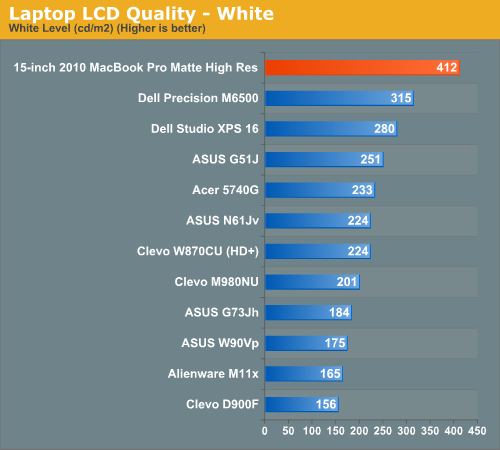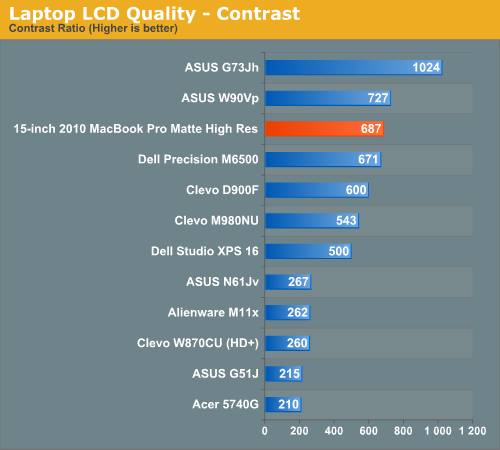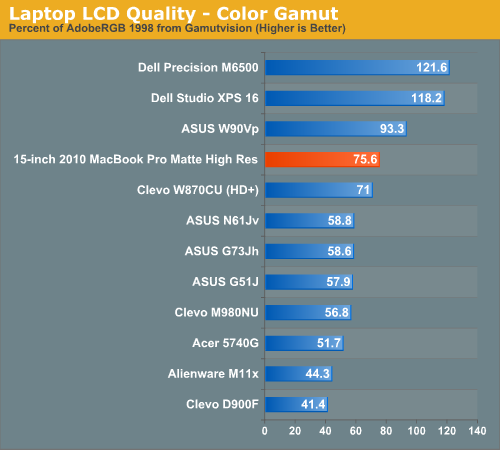Apple's 15-inch 2010 MacBook Pro: More Battery Life Tests, High Res Display Evaluated
by Anand Lal Shimpi on April 24, 2010 1:57 AM EST- Posted in
- Mac
- Displays
- MacBook Pro
- Arrandale
- Laptops
High Resolution, Matte Display: Tested
For creative professionals and digital photography or videography enthusiasts alike, LCD quality of the MacBook Pro is a huge consideration. Luckily, Apple delivers in this department.
Apple thankfully provides matte high resolution display options for both the 15” and 17” MacBook Pros. If you’re partial to glossy displays, there’s also a glossy high resolution display option available online, though it isn’t one of the SKUs that will be stocked in Apple retail stores - you’ll have to order it online.
Since many creative professionals likely will seek the matte option (and because it’s the only high resolution display option available in-store), we chose to do monitor profiling and analysis with this particular model. On the surface, very little has changed, the display itself still substitutes the black glass bezel for an aluminum one. The LCD sits inset from the aluminum bezel about a millimeter, diminishing the chances of your keyboard smudging and scratching up the display like what was so endemic with the pre-unibody design.
| 15-inch 2010 MacBook Pro 6,2 Core i7 | |||
|
Matte High Resolution Display Option
|
|||
| Panel Type | TN (Samsung LTN154MT07) | ||
| Pixel Pitch | 0.197mm | ||
| Viewable Size | 15.4 diagonal | ||
| Resolution | 1680 x 1050 (WSXGA+) | ||
| Screen Treatment | Matte (anti-glare) | ||
The first thing that strikes you about the 2010 MacBook Pro LCD is how bright it is. As we’ll show in a minute, it’s the brightest LCD we’ve tested, thanks in part to its WLED backlighting. While the color gamut is only above average, Delta E tracking is also very good.
For these tests, we used ColorEyes Display Pro with an X-Rite Eye-One Display 2 colorimeter. I originally tested at maximum brightness, and then at precisely 200 nits of luminance. The black level down below is given at maximum brightness. Interestingly enough, Delta E tracking and color accuracy remains largely the same at both settings.
Another note I’ll leave you with is that although using a calibration tool is still an absolute must for the best monitor performance, Apple’s display profile that ships with OS X is surprisingly good. Out of box, the display’s white point was almost exactly 6500K, and the LUT curves subjectively nearly matched those that eventually resulted after calibration. Color tracking and Delta E weren’t good, but subjectively the display looked good.





The LED backlight Apple uses in the display still isn’t RGB LED, so color gamut isn’t anything spectacular, but it isn’t bad either. Performance is average, but what we get is both expected and pretty good for this class of LED backlit notebook displays.


Display uniformity is very good; there is virtually no distracting light leakage from any of the displays. In addition, black level is very good throughout. The viewing angles remain largely what you’d expect from any TN panel in its class. There isn’t an overwhelming amount of color shift when viewing the monitor at horizontal angles. Vertical is another story - there’s a tight range of vertical angles over which the color shift is negligible.
The performance we get with the MacBook Pro’s display is very good - but it still could be better. Among WLED backlit, TN packing notebook LCDs, it certainly shines out as one of the best options. That said, there’s no reason this “Pro” notebook shouldn’t see RGB LED backlighting and potentially even an IPS panel as options soon. Enthusiasts and professionals are more than willing to shell out the cash for large gamut LCDs on the desktop - why not on the notebook? It’s obvious that Apple isn’t averse to IPS panels, especially considering the iPad.
















69 Comments
View All Comments
Anand Lal Shimpi - Saturday, April 24, 2010 - link
If you're referring to the upcoming slate PCs I don't believe any of them are out yet. We've contacted HP and expressed our interested in reviewing the HP slate, so we should be good to go whenever they start shipping :)As far as the other Arrandale based notebooks go, we've got a lot on our list. Jarred and his team have been cranking through them but I'll see about the possibility of getting an HP Arrandale machine in there.
Take care,
Anand
serkol - Saturday, April 24, 2010 - link
I have a very old 17" macbook pro with a TN panel. I hate TN panels. All my desktop monitors are IPS.I assumed that Apple uses IPS panels in their new mbp. Do they also use TN panels in 17" models?
icrf - Saturday, April 24, 2010 - link
I read somewhere that IPS panels consume more power than TN panels. It had something to do with the panel letting less light through so it needed brighter back lights or something. Plus, they're more expensive to produce.The thing most people notice about them is the increased viewing angle, and that's generally not a factor with laptops nearly as much as it is with other devices. It is much more important on mobile devices, which is why Apple chose IPS for the iPad.
serkol - Saturday, April 24, 2010 - link
I think that laptops need panels with good viewing angles (IPS or at least MA panels). If a cell phone battery (and iPad battery) has enough power to light an IPS screen, a laptop battery definitely has enough power. If it's bright enough for iPad - it's bright enough for a laptop. I don;t see any technical reason to keep using cheap TN panels in expensive pro-level macbook pros. The only reason - greed.Cali3350 - Saturday, April 24, 2010 - link
Is the 1440*900 screen still of the same quality as the previous generations? I dont want the high res but heard they are now using a slightly worse panel (it does have a different model number).jeffbui - Saturday, April 24, 2010 - link
Are you guys compensating for the diminished battery capacity of the older computers in any way? The newer notebooks all have an inherent advantage with their fresh battery.darkswordsman17 - Saturday, April 24, 2010 - link
I greatly prefer glossy to matte, it just looks so much nicer. To my eyes, matte has a shimmering veil and if glare would be a problem on a glossy display it would be even worse on a matte one for me, as matte generally just blurs the glare so that you get this big blob of light instead of a reflection. That's not always true, but the glare/reflection that matte gets rid of isn't bothersome to me on glossy displays. I also get the screen door effect on matte displays, or rather it becomes noticeable to me.I've never agreed when people say that matte gives you an accurate image. I know that the devices used to calibrate displays can't work properly on glossy (or at least that was one of the big issues a few years back, so maybe they've improved since then?), but when it comes down to it, the matte finish isn't offering an acurate image either. At least not to my eyes.
Unfortunately, all the quality panels get paired with matte, so you're stuck with a not very good panel to get glossy or pony up to get a good quality one with matte.
I'd like to see them use a glossy finish, but then apply a matte/anti-glare screen protector, this way if you want matte you can leave it on, but if you want glossy you can just peel it off. Or maybe offer where you can just swap the bezel.
One last thing, when are we going to get an OS that will let us scale what's being displayed on the fly, sort of like how we can zoom in/out on browsers on smartphones, but this would work all over. I know we can adjust DPI settings and text size, but that often doesn't work perfectly, and you have to navigate settings menus. I'd be happy with even just being able to in a browser, as there's so many sites that have large amounts of empty space. Make it so that you can hold the left click button and then scroll which would zoom in and out?
Computer Scooter Joe - Saturday, April 24, 2010 - link
It sounds like you are referring to a functionality that already exists. If you hold down Ctrl + Scroll the scroll wheel, the page will zoom in and out.IceBreakerG - Saturday, April 24, 2010 - link
Hey Anand, thanks for the update on the 15" MacBook Pro. I bought mine last week from Amazon for my birthday, and so far have been pretty happy with it. Doing a lot of experimenting and testing. This is my first "real" mac, my only other experience was with osx86, and that was a different experience. Either way, I decided to go with VMware Fusion 3 because Parallels Desktop 5 did not work for me with Windows 7 in Bootcamp (and I need to be able to boot to Windows 7 natively).Anyway, is there anyway you can say what type of hit I'd take on battery life running Windows 7 in VMware Fusion? I'm not sure if it triggers the dGPU or not, so I don't know if it's just more cycles or something else. I'm assuming I'll most definitely suffer "worse" battery life due to more resources being used, but I'm not sure how much worse. One of the reasons I got the laptop was to be able to run Office 2010 and Visual Studio 2010 in it, but battery life was very important too. Just curious to know if you've done any battery life tests with virtualization as well. Thanks.
dver - Saturday, April 24, 2010 - link
The higher resolution is a welcome option, though I'd prefer a 1080 option. The smaller pixel size the better for me. Having now used the 27" iMac screen for a couple months I can honestly say i'll never use anything but glossy now. It's a true wonder to behold. For me there's no contest...matte screens look so terrible now, I can't stand em. I can't bring myself to go TN though, so I'll be waiting and hoping for an ips option in the future.Great review as always!